The State of the Hydrographic Survey and Assessment of the Potentially Risky Region for Navigation Safety
Abstract
1. Introduction
2. Literature Review
3. Methodology
3.1. Stage 1: Analysis of the Current State of the Hydrographic Survey by IHO Regions
3.2. Stage 2: Determining Coastline Length and Sea Surface by IHO Regions
3.3. Stage 3: Calculating the Correlation between Hydrographic Survey Status and Geographical Characteristics between IHO Regions
3.4. Stage 4: Analysis of Stranded Ships by IHO Regions
3.5. Stage 5: Results and Conclusions
4. Results and Discussion
4.1. The Results of the Hydrographic Survey, Coastline Length, and Sea Surface by IHO Regions
4.2. Stranded Ships from 2010–2021 by IHO Regions (Case Study Results)
5. Limitations of the Study
6. Conclusions
Author Contributions
Funding
Institutional Review Board Statement
Informed Consent Statement
Data Availability Statement
Acknowledgments
Conflicts of Interest
References
- Duan, J.; Wan, X.; Luo, J. Research on the hydrographic survey cycle for updating navigational charts. J. Navig. 2021, 74, 750–762. [Google Scholar] [CrossRef]
- Kasum, J.; Zec, D.; Bićanić, Z. The compliance of the data of sea charts and navigational publications in comparison to actual state. Int. J. Marit. Sci. Technol. Our Sea 2002, 49, 165–170. [Google Scholar]
- International Hydrographic Organisation IHO. The Need for National Hydrographic Services M-2, Version 3.0.7; International Hydrographic Bureau: Monaco, 2018.
- Law on Hydrographic Activity, Official Gazette 68/98; 110/98; 163/03, and 71/14. Available online: https://mmpi.gov.hr/sea/hydrographic-activity/22171 (accessed on 7 August 2021).
- Golub Medvešek, I. A Method of Hydrographic Survey Technology Selection based on the Decision Tree Supervised Learning. Ph.D. Thesis, University of Split, Faculty of Maritime Studies, Split, Croatia, 2021. [Google Scholar]
- Hell, B.; Broman, B.; Jakobsson, M.; Magnusson, A.; Wiberg, P. The Use of Bathymetric Data in Society and Science: A Review from the Baltic Sea. Ambio 2012, 41, 138–150. [Google Scholar] [CrossRef]
- United Nations Conference on Trade and Development (UNCTAD). Review of Maritime Transport 2017; United Nations Publication: New York, NY, USA, 2017. [Google Scholar]
- Laxian, F.; Zhang, S.; Yin, J. Structural Analysis of Shipping Fleer Capacity. J. Adv. Transp. 2018, 2018, 3854090. [Google Scholar] [CrossRef]
- Douglas, C.B.; Nairn, R. The Economic Benefit of Hydrography and Ocean Mapping. In Proceedings of the FIG 6th Regional Conference; San Jose, Costa Rica, 12–15 November 2007, 2009; pp. 2–26. [Google Scholar]
- Golub Medvešek, I.; Vujović, I.; Šoda, J.; Krčum, M. A Novel Method on Hydrographic Survey Technology Selection Based on the Decision Tree Supervised Learning. Appl. Sci. 2021, 11, 4966. [Google Scholar] [CrossRef]
- Weintrit, A. Accuracy of Bathymetric Data in the Electronic Navigational Charts. Sci. J. Marit. Univ. Szczec. 2018, 127, 60–69. [Google Scholar] [CrossRef]
- Wright, R.G. Virtual Aids to Navigation. Ph.D. Thesis, World Maritime University, Malmo, Sweden, 2017. [Google Scholar]
- Douglas, C.B.; Nairn, R. Economic: Impact of Hydrographic Surveys. In Proceeding of the XXIV FIG International Congress 2010: Facing the Challenges—Building the Capacity, Sydney, Australia, 11–16 April 2010. [Google Scholar]
- Le Deunf, J.; Debese, N.; Schmitt, T.; Billot, R. A Review of Data Cleaning Approaches in a Hydrographic Framework with a Focus on Bathymetric Multibeam Echosounder Datasets. Geosciences 2020, 7, 254. [Google Scholar] [CrossRef]
- Wang, S.; Dai, L.; Wu, Z.; Li, J.; Wei, Y. Multibeam Bathymetric Data Quality Control based on Robust Least Square Collocation of Improved Multi-quadric Function. J. Eng. Sci. Technol. Rev. 2018, 11, 139–146. [Google Scholar] [CrossRef]
- Ferreira, I.O.; Santos, A.; Oliveira, J.C.; Medeiros, N.; Emiliano, P.C. Spatial outliers detection algorithm (soda) applied to multibeam bathymetric data processing. Bol. De Cienc. Geod. 2019, 25, 1–15. [Google Scholar] [CrossRef]
- Masetti, G.; Faulkes, T.; Wilson, M.; Wallace, J. Effective Automated Procedures for Hydrographic Data Review. Geomatics 2022, 2, 338–354. [Google Scholar] [CrossRef]
- Wlodarczyk-Sielicka, M.; Blaszczak-Bak, W. Processing of Bathymetric Data: The Fusion of New Reduction Methods for Spatial Big Data. Sensors 2020, 20, 6207. [Google Scholar] [CrossRef] [PubMed]
- Deunf, J.L.; Khannoussi, A.; Lecornu, L.; Meyer, P.; Puentes, J. Automatic Data Quality Assessment of Hydrographic Surveys Taking into Account Experts’ Preferences. In Proceedings of the OCEANS 2021, San Diego—Porto, Porto, Portugal, 20–23 September 2021; pp. 1–10. [Google Scholar]
- Agrafiotis, P.; Karantzalos, K.; Georgopoulos, A.; Skarlatos, D. Correcting Image Refraction: Towards Accurate Aerial Image-Based Bathymetry Mapping in Shallow Waters. Remote Sens. 2020, 12, 322. [Google Scholar] [CrossRef]
- Agrafiotis, P.; Karantzalos, K.; Georgopoulos, A.; Skarlatos, D. Learning from Synthetic Data: En-hancing Refraction Correction Accuracy for Airborne Image-Based Bathymetric Mapping of Shallow Coastal Waters. J. Photogramm. Remote Sens. Geoinf. Sci. 2021, 89, 91–109. [Google Scholar] [CrossRef]
- Agrafiotis, P.; Karantzalos, K.; Georgopoulos, A.; Skarlatos, D. DepthLearn: Learning to Correct the Refraction on Point Clouds Derivated from Aerial Imagery for Accurate Dense Shallow Water Bathymetry Based on SVMs—Fusion with LiDAR Point Clouds. Remote Sens. 2019, 11, 2225. [Google Scholar] [CrossRef]
- Birkebak, M.; Eren, F.; Pe’eri, S.; Weston, N. The Effect of Surface Waves on Airborne LiDAR Bathymetry (ALB) Measurement Uncertainties. Remote Sens. 2018, 10, 453. [Google Scholar] [CrossRef]
- Corcoran, F.; Parrish, C.E. Diffuse Attenuation Coefficient (Kd) from ICESat-2 ATLAS Spaceborne LiDAR Using Random-Forest Regression. Photogramm. Eng. Remote Sens. 2021, 87, 831–840. [Google Scholar] [CrossRef]
- Xu, W.; Guo, K.; Liu, Y.; Tian, Z.; Tang, Q.; Dong, Z.; Li, J. Refraction Error Correction of Airborne LiDAR Bathymetry Data Considering Sea Surface Waves. Int. J. Appl. Earth Obs. Geoinf. 2021, 102, 102402. [Google Scholar] [CrossRef]
- Maratos, A.; Weintrit, A. The IHO Supporting Maritime Demands—Report on the Occasion of Celebrating the World Hydrography Day with theme for this year: Electronic Navigational Charts (ENCs). an Essential Element of Safety at Sea and Efficient Maritime Operations; In Advances in Marine Navigation and Safety of Sea Transportation. TransNav’2007; Gdynia Maritime University: Gdynia, Poland, 2007; pp. 733–739. [Google Scholar]
- Al Najar, M.; El Bennioui, Y.; Thoumyre, G.; Almar, R.; Bergsma, E.W.J.; Benshila, R.; Delvit, J.M.; Wilson, D.G. A combined color and wave-based approach to satellite derived bathymetry using deep learning. Int. Arch. Photogramm. Remote Sens. Spat. Inf. Sci. 2022, 43, 9–16. [Google Scholar] [CrossRef]
- Al Najar, M.; Thoumyre, G.; Bergsma, E.W.J.; Almar, R.; Benshila, R.; Wilson, D.G. Satellite derived bathymetry using deep learning. Mach. Learn. 2021, 112, 1107–1130. [Google Scholar] [CrossRef]
- Dickens, K.; Armstrong, A. Application of Machine Learning in Satellite Derived Bathymetry and Coastline Detection. SMU Data Sci. Rev. 2019, 2, 4. Available online: https://scholar.smu.edu/datasciencereview/vol2/iss1/4 (accessed on 17 October 2021).
- Eugenio, F.; Marcello, J.; Mederos-Barrera, A.; Marqués, F. High-resolution satellite bathymetry mapping: Regression and machine learning-based approaches. IEEE Trans. Geosci. Remote Sens. 2022, 60, 5407614. [Google Scholar] [CrossRef]
- Lumban-Gaol, Y.; Ohori, K.A.; Peters, R. Extracting Coastal Water Depths from Multi-Temporal Sentinel-2 Images Using Convolutional Neural Networks. Mar. Geod. 2022, 45, 615–644. [Google Scholar] [CrossRef]
- Mudiyanselage, S.; Abd-Elrahman, A.; Wilkinson, B.; Lecours, V. Satellite-derived bathymetry using machine learning and optimal Sentinel-2 imagery in South-West Florida coastal waters. GISci. Remote Sens. 2022, 59, 1143–1158. [Google Scholar] [CrossRef]
- Sagawa, T.; Yamashita, Y.; Okumura, T.; Yamanokuchi, T. Satellite Derived Bathymetry Using Machine Learning and Multi-Temporal Satellite Images. Remote Sens. 2019, 11, 1155. [Google Scholar] [CrossRef]
- Mallégol, A.; Meyer, P.; Loyer, S. A hydrographic risk assessment methodology integrating the user’s preferences: Application to a use-case in the English Channel. In Proceedings of the 92nd Meeting of the EURO Working Group on Multi-Criteria Decision Aiding (EWG-MCDA 92), Krakow, Poland, 13 September 2021. [Google Scholar]
- Chénier, R.; Abado, L.; Martin, H. CHS Priority Planning Tool (CPPT)—A GIS Model for Defining Hydrographic Survey and Charting Priorities. ISPRS Int. J. Geo-Inf. 2018, 7, 240. [Google Scholar] [CrossRef]
- Leyzack, A.; Chenier, R.; Hinds, S. Marine Corridors: A Methodology for Planning and Prioritizing Surveys, Products and Services. In Proceedings of the Canadian Hydrographic Conference, St. John’s, NL, Canada, 14–17 April 2014. [Google Scholar]
- Wright, R.G.; Baldauf, M. Hydrographic Survey in Remote Regions: Using Vessels of Opportunity Equipped with 3-Dimensional Forward-Looking Sonar. Mar. Geod. 2016, 39, 439–457. [Google Scholar] [CrossRef]
- Hamann, R.; Sames, P.C. Updated and expanded casualty analysis of container vessels. Ship Technol. Res. 2022, 69, 158–169. [Google Scholar] [CrossRef]
- Galić, S.; Lušić, Z.; Mladenović, S.; Gudelj, A. A Chronological Overview of Scientific Research on Ship Grounding Frequency Estimation Models. J. Mar. Sci. Eng. 2022, 10, 207. [Google Scholar] [CrossRef]
- Tang, Y.; Mao, Y.; Wu, M.; Shi, T.; Fan, C. Probability Analysis of Ship Collision and Grounding in Inland Waterway Based on Big Data Analysis. J. Phys. Conf. Ser. 2020, 1486, 052016. [Google Scholar] [CrossRef]
- Zhao, C. Use of Fuzzy Fault Tree Analysis and Noisy-OR Gate Bayesian Network for Navigational Risk Assessment in Qingzhou Port. TransNav Int. J. Mar. Navig. Saf. Sea Transp. 2021, 15, 765–771. [Google Scholar] [CrossRef]
- Eliopoulou, E.; Alissafaki, A.; Papanikolaou, A. Statistical Analysis of Accidents and Review of Safety Level of Passenger Ships. J. Mar. Sci. Eng. 2023, 11, 410. [Google Scholar] [CrossRef]
- Eliopoulou, E.; Papanikolaou, A.; Voulgarellis, M. Statistical analysis of ship accidents and review of safety level. Saf. Sci. 2016, 85, 282–292. [Google Scholar] [CrossRef]
- Ventikos, N.P.; Papanikolaou, A.D.; Louzis, K.; Koimtzoglou, A. Statistical Analysis and Critical Review of Navigational Accidents in Adverse Weather Conditions. Ocean. Eng. 2018, 163, 502–517. [Google Scholar] [CrossRef]
- Vassalos, D.; Luhmann, H.; Cardinale, M.; Hamann, R.; Papanikolaou, A.; Paterson, D. A Multi-Level Approach for Flooding Risk Estimation and Assessment of Passenger Ships. In Proceedings of the SNAME Maritime Convention 2022, Houston, TX, USA, 26–29 September 2022. [Google Scholar]
- Melnyk, O.; Bychkovsky, Y.; Shumylo, O.; Onyshchenko, S.; Onishchenko, O.; Voloshyn, A.; Cheredarchuk, N. Study of the Risk Assessment Quality Dependence on the Ships Accidents Analysis. Sci. Bull. Nav. Acad. 2022, 25, 136–146. [Google Scholar] [CrossRef]
- Wang, Y.; Zhang, F.; Yang, Z.; Yang, Z. Incorporation of deficiency data into the analysis of the dependency and interdependency among the risk factors influencing port state control inspection. Reliab. Eng. Syst. Saf. 2021, 213, 206. [Google Scholar] [CrossRef]
- Yim, J. A study on the analysis and identification of seafarers’ skill-rule-knowledge inherent in maritime accidents. J. Korean Soc. Mar. Environ. Saf. 2017, 23, 224–230. [Google Scholar] [CrossRef]
- Wang, Z.; Yin, J. Risk assessment of inland waterborne transportation using data mining. Marit. Policy Manag. 2020, 47, 633–648. [Google Scholar] [CrossRef]
- Grech, M.R.; Horberry, T.; Smith, A. Human Error in Maritime Operations: Analyses of Accident Reports Using the Leximancer Tool. In Proceedings of the Human Factors and Ergonomics Society Annual Meeting; Sage Publications: Los Angeles, CA, USA, 2020; Volume 46, pp. 1718–1721. [Google Scholar]
- Stratmann, T.C.; Boll, S. Demon Hunt—The Role of Endsley’s Demons of Situation Awareness in Maritime Accidents. In Human-Centered and Error-Resilient Systems Development, Lecture Notes in Computer Science; Springer International Publishing: Berlin/Heidelberg, Germany, 2016; Volume 9856, pp. 203–212. [Google Scholar] [CrossRef]
- Dominguez-Péry, C.; Tassabehji, R.; Corset, F.; Chreim, Z. A holistic view of maritime navigation accidents and risk indicators: Examining IMO reports from 2011 to 2021. J. Shipp. Trd. 2023, 8, 11. [Google Scholar] [CrossRef]
- Yasir, M.; Hui, S.; Binghu, H.; Rahman, S.U. Coastline extraction and land use change analysis using remote sensing (RS) and geographic information system (GIS) technology—A review of the literature. Rev. Environ. Health 2020, 35, 453–460. [Google Scholar] [CrossRef]
- Cenci, L.; Disperati, L.; Persichill, M.G.; Oliveira, E.R.; Alves, F.; Phillips, M. Integrating remote sensing and GIS techniques for monitoring and modeling shoreline evolution to support coastal risk management. GISci. Remote Sens. 2017, 55, 355–375. [Google Scholar] [CrossRef]
- Matin, N.; Hasan, G. A quantitative analysis of shoreline changes along the coast of Bangladesh using remote sensing and GIS techniques. Catena 2021, 201, 105185. [Google Scholar] [CrossRef]
- Ghorai, D.; Mahapatra, M. Extracting Shoreline from Satellite Imagery for GIS Analysis. Remote Sens. Earth Syst. Sci. 2020, 3, 6061. [Google Scholar] [CrossRef]
- Kulawiak, M.; Chybicki, A. Application of Web-GIS and geovisual analytics to monitoring of seabed evolution in South Baltic Sea coastal areas. Mar. Geod. 2018, 41, 405–426. [Google Scholar] [CrossRef]
- International Hydrographic Organization. IHO C-55: Publication C-55—Status of Hydrographic Surveying and Charting Worldwide; International Hydrographic Bureau: Monaco, 2020; Available online: https://iho.int/uploads/user/pubs/cb/c-55/c55.pdf (accessed on 28 October 2022).
- Pavlić, I. Statistička Teorija i Primjena; Tehnička Knjiga: Zagreb, Croatia, 1988. [Google Scholar]
- Stanchev, H.; Palazov, A.; Stancheva, M.; Apostolov, A. Determination of the Black Sea coastline length/area using GIS methods and LandSat 7 Satellite Images. Geo-Eco-Marina 2011, 17, 27–31. [Google Scholar] [CrossRef]
- Chang, K.T. Geographic Information System. In International Encyclopedia of Geography: People, the Earth, Environment and Technology; John Wiley & Sons: Hoboken, NJ, USA, 2016; pp. 1–10. [Google Scholar]
- QGIS. Quantum Geographic Information System. Available online: www.qgis.org (accessed on 22 August 2002).
- IHO Web Catalogue. Available online: http://chart.iho.int:8080/iho/main.do (accessed on 22 August 2002).
- IHO World Seas. Available online: https://marineregions.org/download_file.php?name=World_Seas_IHO_v3.zip (accessed on 22 August 2002).
- Owen, B.; Lazebnik, F.; Smeltzer, D.L. Methods for Euclidean Geometry; The Mathematical Association of America: Washington, DC, USA, 2010; ISBN 978-0-88385-763-2. [Google Scholar]
- Wolfgang, K. The Mathematics of GIS; University of Vienna: Vienna, Austria, 2010. [Google Scholar]
- Brown, W.A. Matrices and Vector Spaces; Dekker: New York, NY, USA, 1991; ISBN 978-0-8247-8419-5. [Google Scholar]
- Nettleton, D. Chapter 6—Selection of Variables and Factor Derivation. In Commercial Data Mining; David, N., Morgan, K., Eds.; Elsevier: Amsterdam, The Netherlands, 2014; pp. 79–104. ISBN 9780124166028. [Google Scholar] [CrossRef]
- Kumar, S.; Ilyoung, C. Correlation Analysis to Identify the Effective Data in Machine Learning: Prediction of Depressive Disorder and Emotion States. Int. J. Environ. Res. Public Health 2018, 15, 2907. [Google Scholar] [CrossRef] [PubMed]
- Kotu, V.; Deshpande, B. Data Science, Concept and Practice, 2nd ed.; Elsevier: Amsterdam, The Netherlands, 2015; pp. 257–273. ISBN 978-0-12-814761-0. [Google Scholar]
- Liu, H.; Chen, C.; Li, Y.; Duan, Z.; Li, Z. Chapter 7—Monitoring and Spatial Prediction of Multidimensional Air Pollutants. In Smart Metro Station Systems; Hui, L., Chao, C., Yanfei, L., Zhu, D., Ye, L., Eds.; Smart Metro Station Systems; Elsevier: Amsterdam, The Netherlands, 2022; pp. 171–200. ISBN 9780323905886. [Google Scholar] [CrossRef]
- Dancey, C.P.; Reidy, J. Statistics without Maths for Psychology; Pearson Education: Harlow, UK, 2007. [Google Scholar]
- Colton, T. Statistics in Medicine; Little Brown and Company: New York, NY, USA, 1974. [Google Scholar]
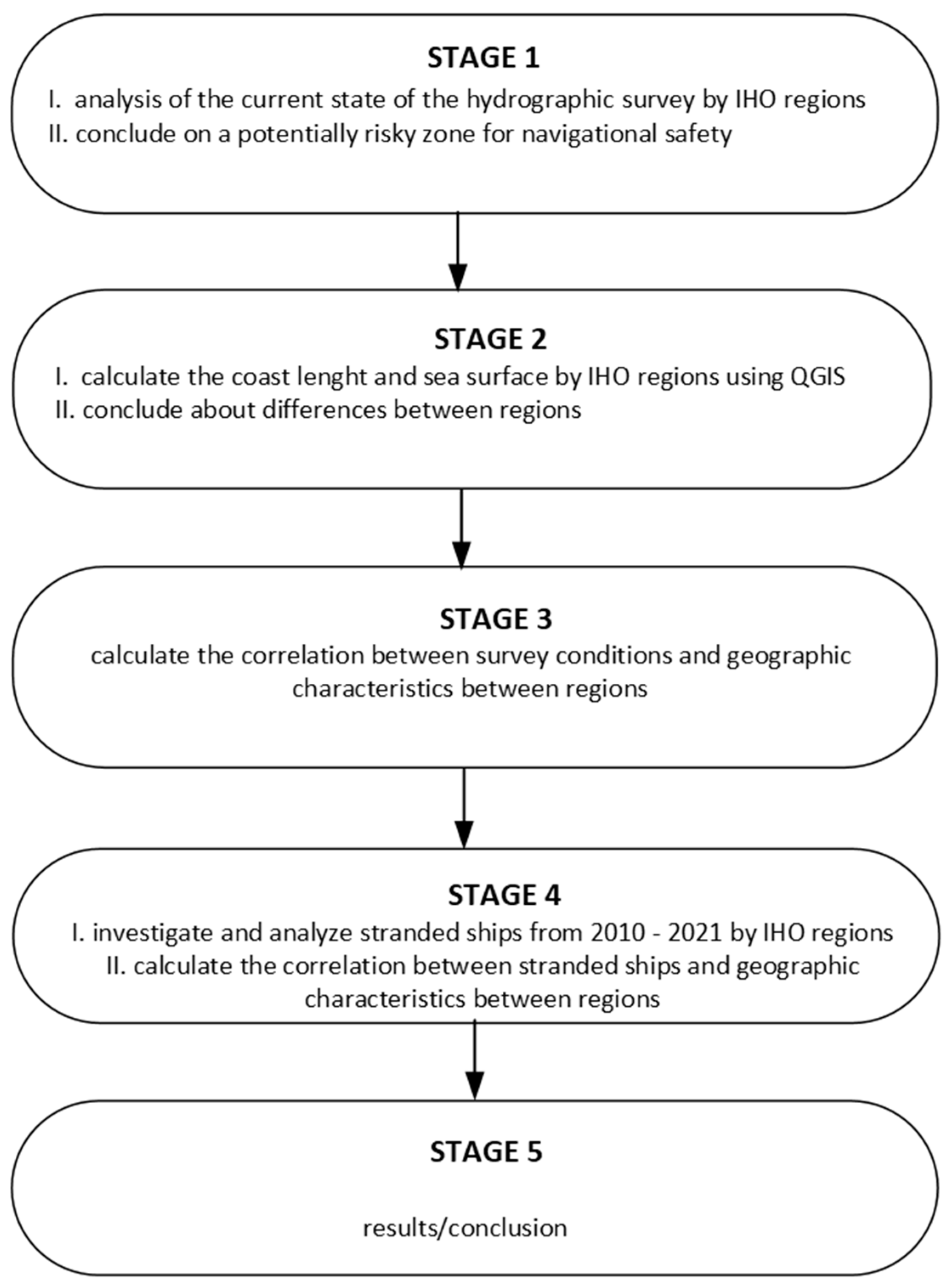



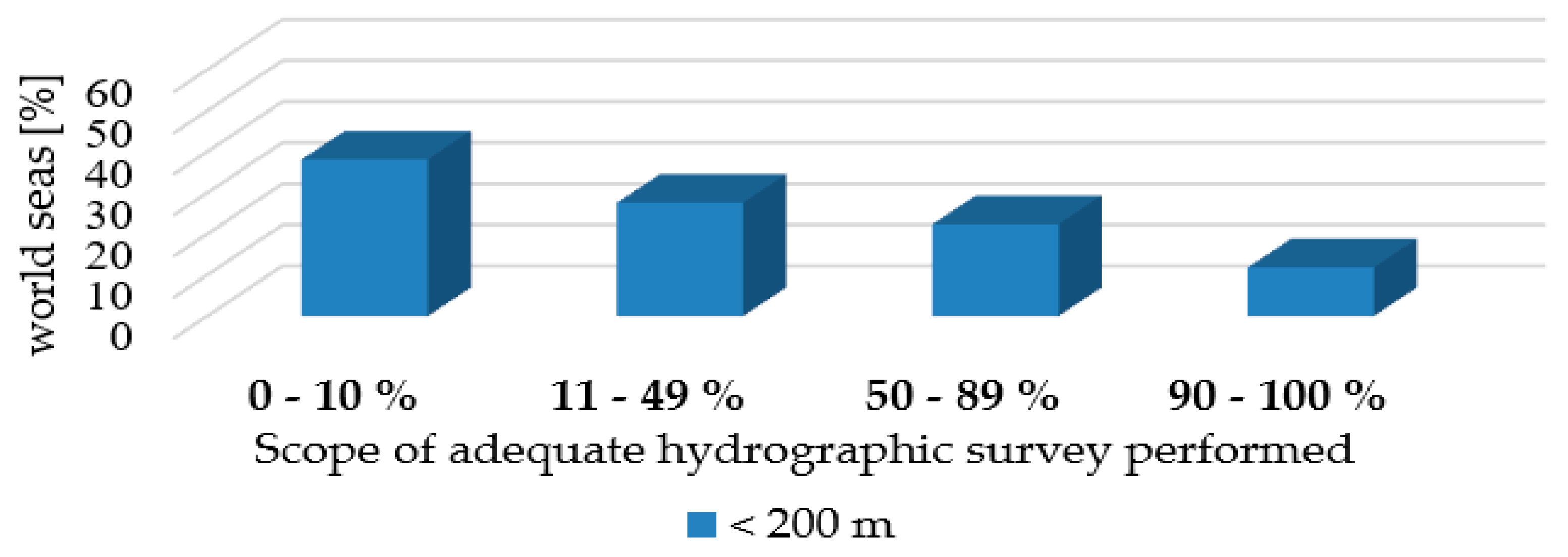
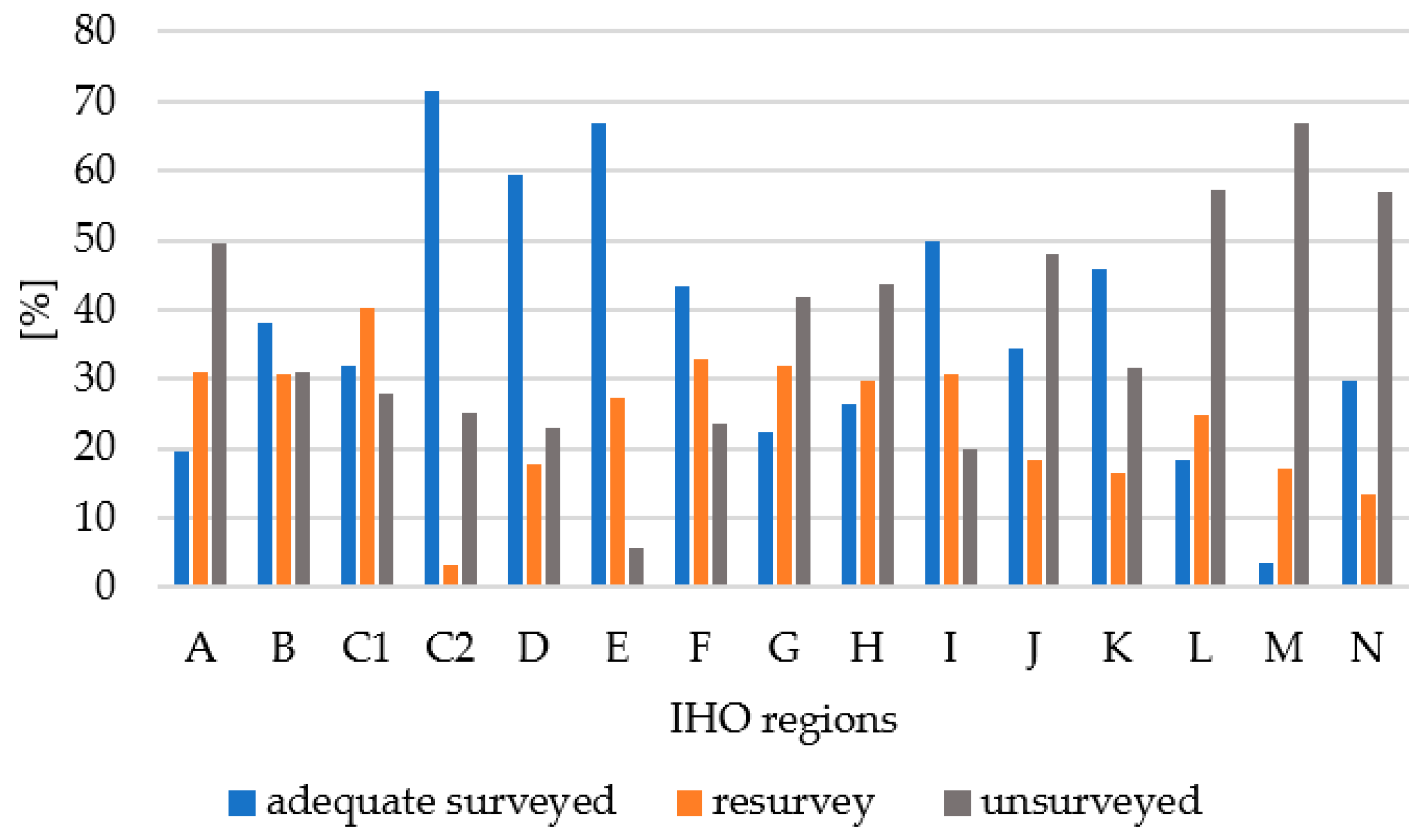
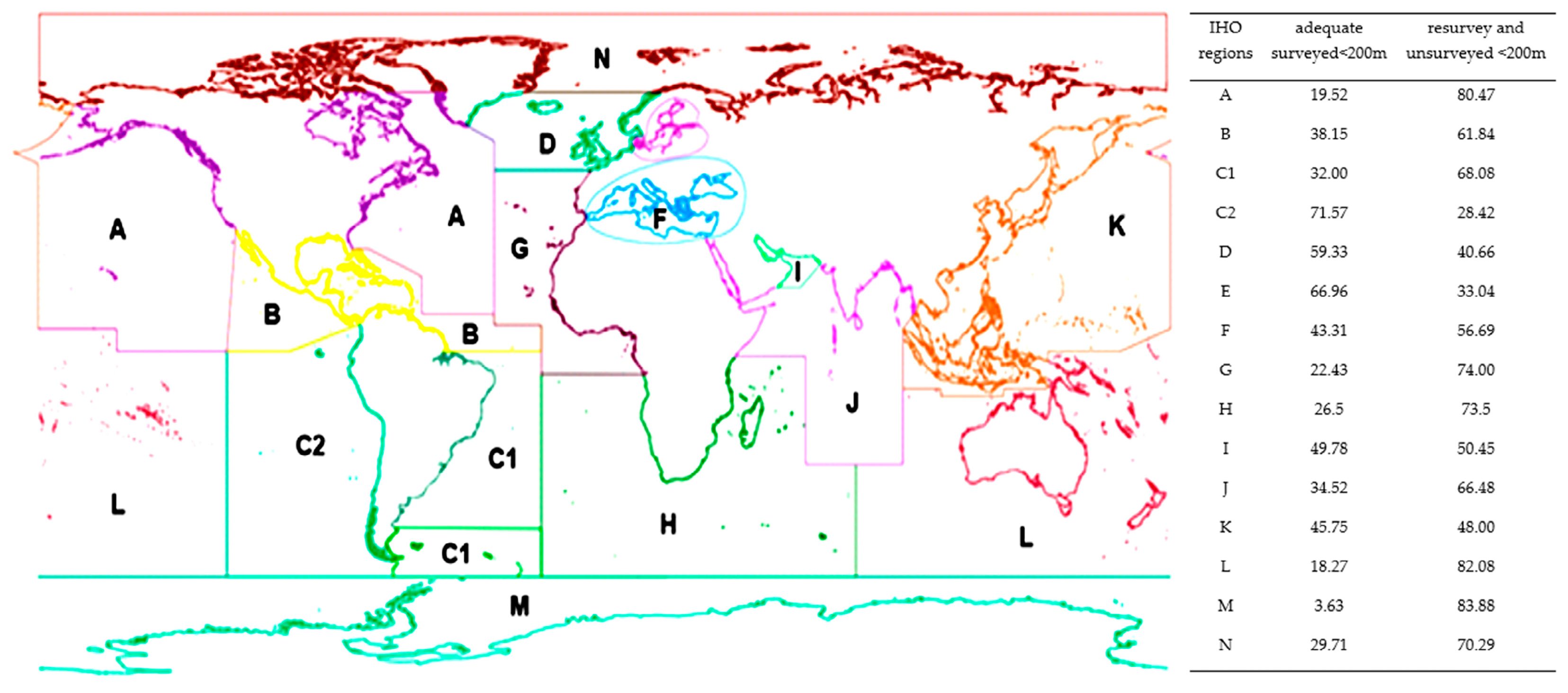
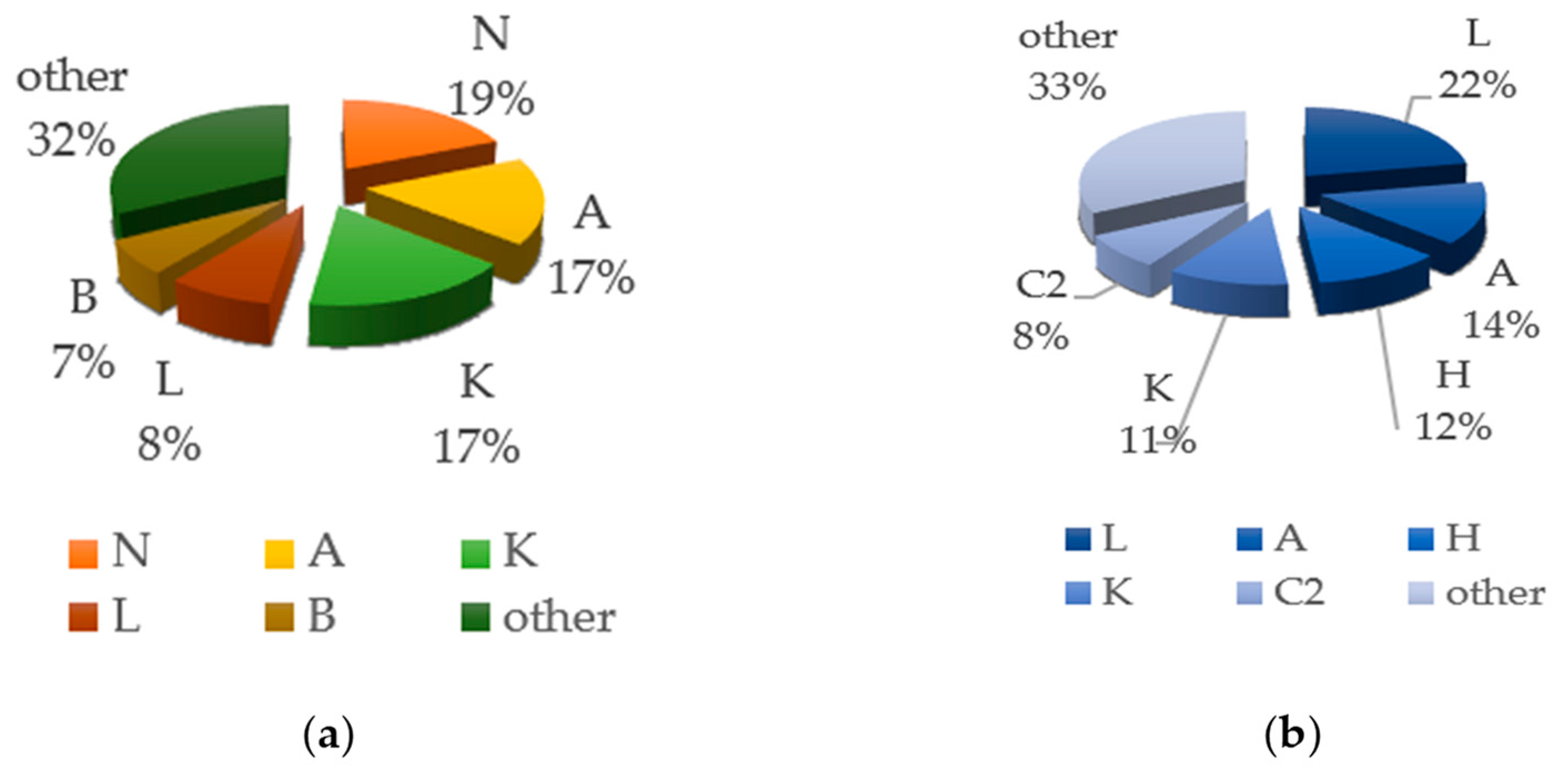
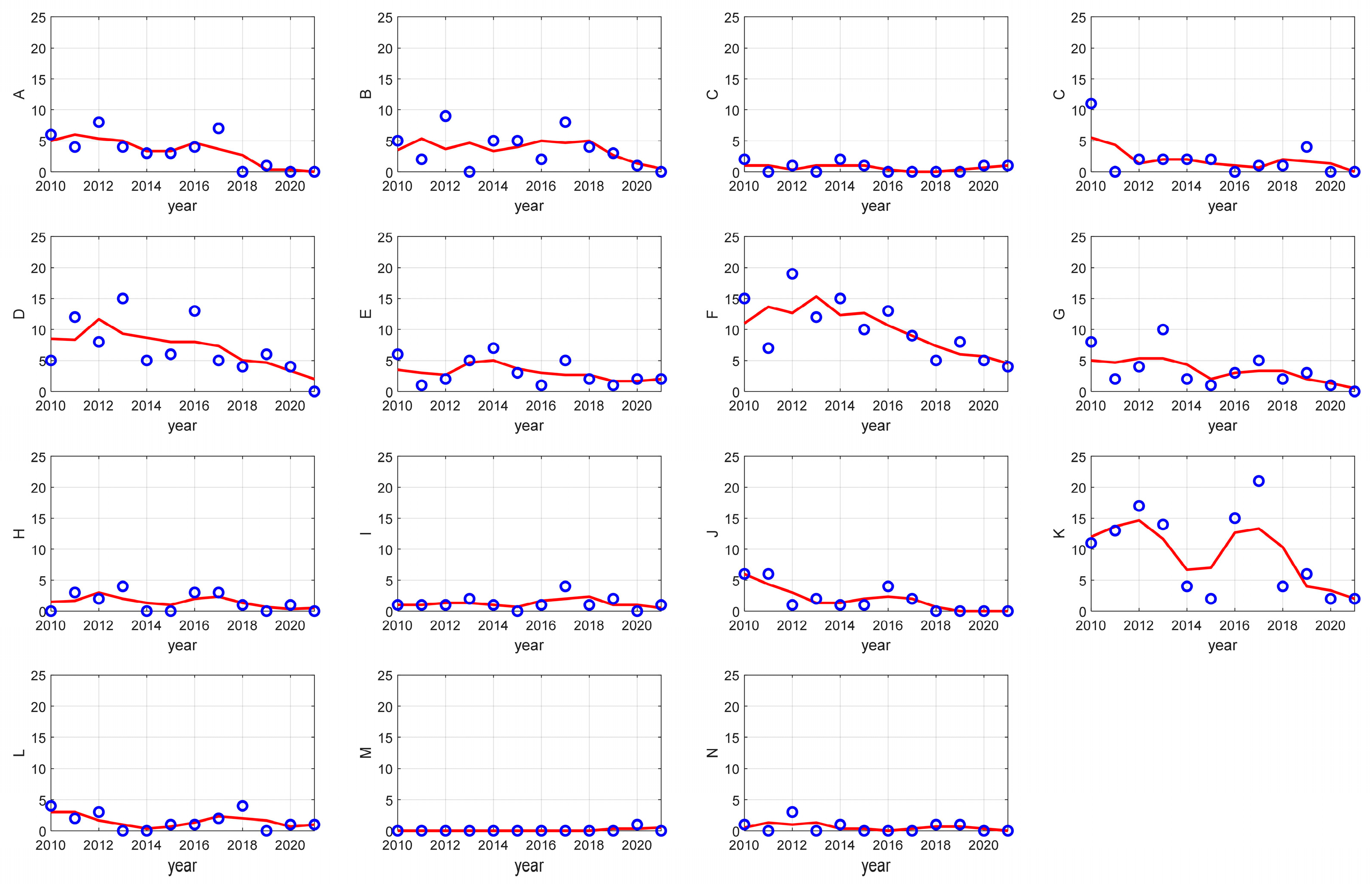
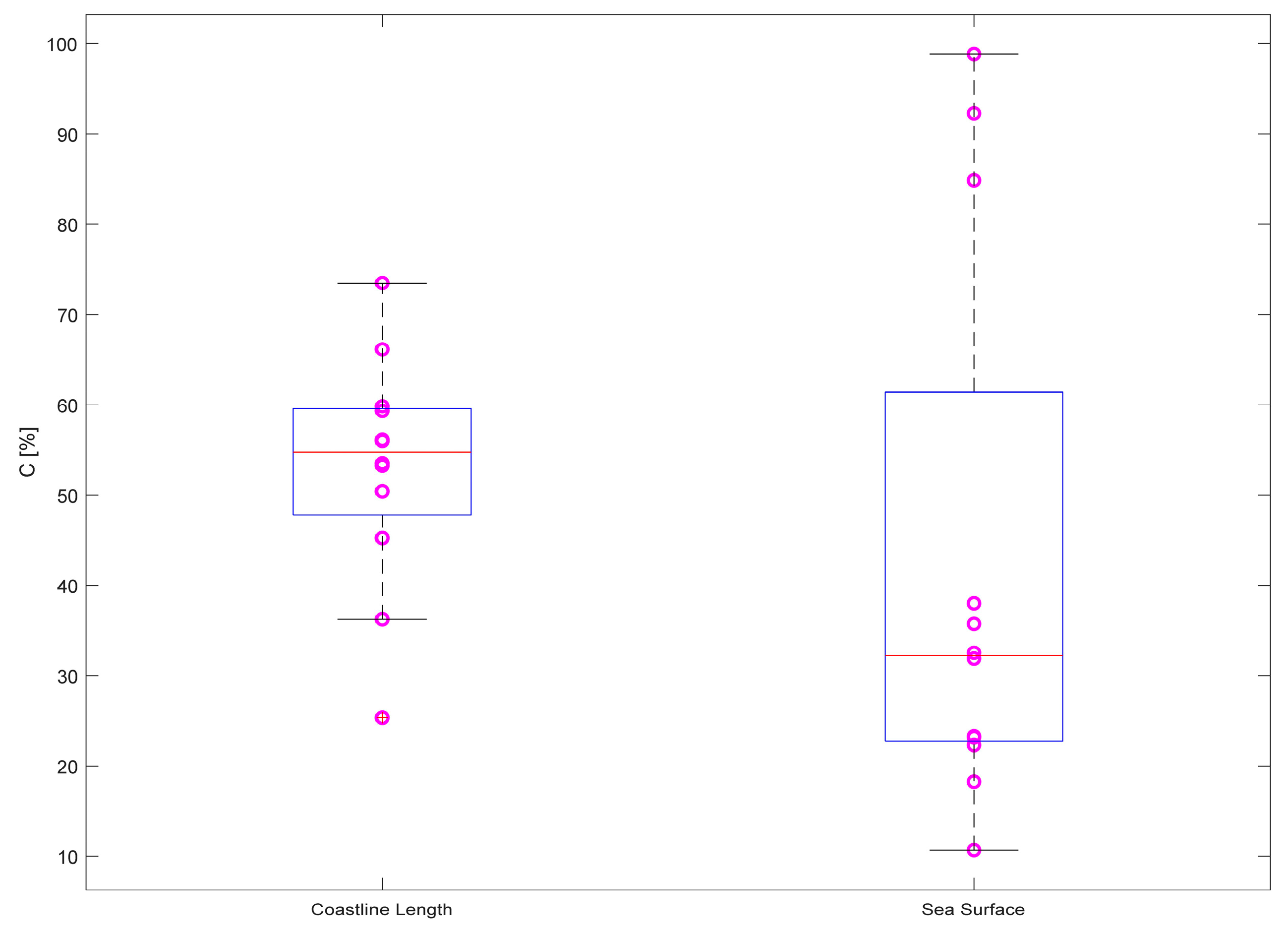
| Range | Strength of Association |
|---|---|
| 0 | No association |
| 0 to ±0.25 | Negligible association |
| ±0.25 to ±0.50 | Weak association |
| ±0.50 to ±0.75 | Moderate association |
| ±0.75 to ±1 | Very strong association |
| ±1 | Perfect association |
| Attributes | Sea Surface | Coastline Length | Adequate Survey | Need to be Resurveyed | Unsurvey | Inaccurate Data |
|---|---|---|---|---|---|---|
| Sea Surface | 1 | 0.146 | −0.516 | −0.353 | 0.631 | 0.408 |
| Coastline Length | 1 | −0.162 | −0.299 | 0.351 | 0.171 | |
| Adequate Survey | 1 | −0.291 | −0.865 | −0.983 | ||
| Need to be resurveyed | 1 | −0.198 | 0.358 | |||
| Unsurvey | 1 | 0.845 | ||||
| Inaccurate Data | 1 |
| Regions | Sea Surface (km2) | Coast Length (NM) | Number of Stranded Ship’s in IHO Regions through the Years | ||||||||||||
|---|---|---|---|---|---|---|---|---|---|---|---|---|---|---|---|
| 2010 | 2011 | 2012 | 2013 | 2014 | 2015 | 2016 | 2017 | 2018 | 2019 | 2020 | 2021 | Total | |||
| A | 51,227,091.1 | 179,875 | 6 | 4 | 8 | 4 | 3 | 3 | 4 | 7 | 0 | 1 | 0 | 0 | 40 |
| B | 17,593,214 | 71,012 | 5 | 2 | 9 | 0 | 5 | 5 | 2 | 8 | 4 | 3 | 1 | 0 | 44 |
| C1 | 18,347,282.6 | 33,285 | 2 | 0 | 1 | 0 | 2 | 1 | 0 | 0 | 0 | 0 | 1 | 1 | 8 |
| C2 | 29,173,572.1 | 49,303 | 11 | 0 | 2 | 2 | 2 | 2 | 0 | 1 | 1 | 4 | 0 | 0 | 25 |
| D | 5,394,984.57 | 56,478 | 5 | 12 | 8 | 15 | 5 | 6 | 13 | 5 | 4 | 6 | 4 | 0 | 83 |
| E | 410,040.85 | 34,170 | 6 | 1 | 2 | 5 | 7 | 3 | 1 | 5 | 2 | 1 | 2 | 2 | 37 |
| F | 2,986,455.38 | 33,696 | 15 | 7 | 19 | 12 | 15 | 10 | 13 | 9 | 5 | 8 | 5 | 4 | 122 |
| G | 14,776,171.6 | 30,830 | 8 | 2 | 4 | 10 | 2 | 1 | 3 | 5 | 2 | 3 | 1 | 0 | 41 |
| H | 43,040,129.9 | 24,052 | 0 | 3 | 2 | 4 | 0 | 0 | 3 | 3 | 1 | 0 | 1 | 0 | 17 |
| I | 1,050,337.55 | 11,734 | 1 | 1 | 1 | 2 | 1 | 0 | 1 | 4 | 1 | 2 | 0 | 1 | 15 |
| J | 22,245,978.8 | 46,379 | 6 | 6 | 1 | 2 | 1 | 1 | 4 | 2 | 0 | 0 | 0 | 0 | 23 |
| K | 40,773,776.2 | 179,220 | 11 | 13 | 17 | 14 | 4 | 2 | 15 | 21 | 4 | 6 | 2 | 2 | 111 |
| L | 79,721,336.4 | 89,256 | 4 | 2 | 3 | 0 | 0 | 1 | 1 | 2 | 4 | 0 | 1 | 1 | 19 |
| M | 2,163,382,645 | 29,519 | 0 | 0 | 0 | 0 | 0 | 0 | 0 | 0 | 0 | 0 | 1 | 0 | 1 |
| N | 1,246,495,013 | 202,414 | 1 | 0 | 3 | 0 | 1 | 0 | 0 | 0 | 1 | 1 | 0 | 0 | 7 |
| Total | 3,736,618,029 | 1,071,223 | 81 | 53 | 80 | 70 | 48 | 35 | 60 | 72 | 29 | 35 | 19 | 11 | 593 |
| The Number of Stranded Ships | ||||||||||||||
|---|---|---|---|---|---|---|---|---|---|---|---|---|---|---|
| 2010 | 2011 | 2012 | 2013 | 2014 | 2015 | 2016 | 2017 | 2018 | 2019 | 2020 | 2021 | Total | ||
| Coastline Length | C [%] | 61.97 | 67.44 | 62.29 | 65.15 | 56.29 | 58.09 | 58.37 | 58.15 | 60.12 | 52.27 | 47.73 | 32.02 | 60.99 |
| p-value | 0.014 | 0.006 | 0.013 | 0.009 | 0.029 | 0.023 | 0.022 | 0.023 | 0.018 | 0.046 | 0.072 | 0.245 | 0.016 | |
| Sea Surface | C [%] | 18.24 | 35.75 | 32.53 | 38.00 | 23.29 | 23.18 | −22.32 | 10.68 | 31.89 | 92.26 | 98.83 | 84.85 | 54.94 |
| p-value | 0.515 | 0.191 | 0.237 | 0.162 | 0.404 | 0.406 | 0.424 | 0.705 | 0.247 | 0.000 | 0.000 | 0.000 | 0.034 | |
Disclaimer/Publisher’s Note: The statements, opinions and data contained in all publications are solely those of the individual author(s) and contributor(s) and not of MDPI and/or the editor(s). MDPI and/or the editor(s) disclaim responsibility for any injury to people or property resulting from any ideas, methods, instructions or products referred to in the content. |
© 2023 by the authors. Licensee MDPI, Basel, Switzerland. This article is an open access article distributed under the terms and conditions of the Creative Commons Attribution (CC BY) license (https://creativecommons.org/licenses/by/4.0/).
Share and Cite
Golub Medvešek, I.; Šoda, J.; Karin, I.; Maljković, M. The State of the Hydrographic Survey and Assessment of the Potentially Risky Region for Navigation Safety. J. Mar. Sci. Eng. 2023, 11, 1498. https://doi.org/10.3390/jmse11081498
Golub Medvešek I, Šoda J, Karin I, Maljković M. The State of the Hydrographic Survey and Assessment of the Potentially Risky Region for Navigation Safety. Journal of Marine Science and Engineering. 2023; 11(8):1498. https://doi.org/10.3390/jmse11081498
Chicago/Turabian StyleGolub Medvešek, Ivana, Joško Šoda, Ivan Karin, and Mislav Maljković. 2023. "The State of the Hydrographic Survey and Assessment of the Potentially Risky Region for Navigation Safety" Journal of Marine Science and Engineering 11, no. 8: 1498. https://doi.org/10.3390/jmse11081498
APA StyleGolub Medvešek, I., Šoda, J., Karin, I., & Maljković, M. (2023). The State of the Hydrographic Survey and Assessment of the Potentially Risky Region for Navigation Safety. Journal of Marine Science and Engineering, 11(8), 1498. https://doi.org/10.3390/jmse11081498








